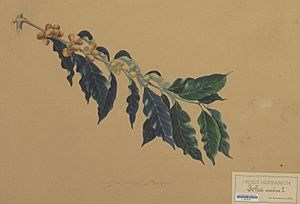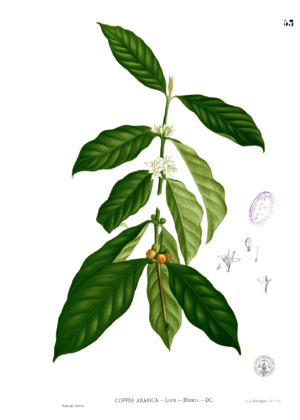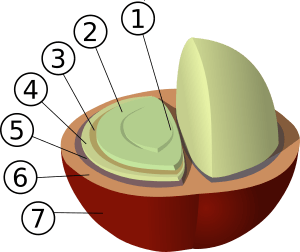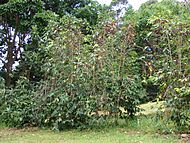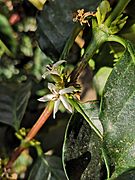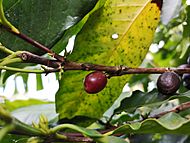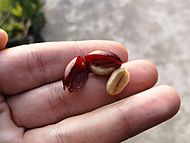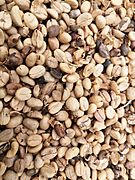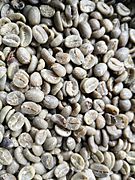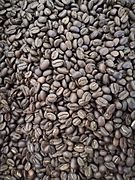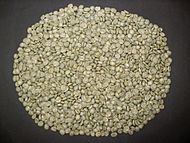Coffea arabica facts for kids
Quick facts for kids Arabic coffee |
|
|---|---|
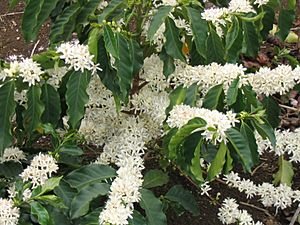 |
|
| Coffea arabica flowers | |
 |
|
| Coffea arabica fruit | |
| Conservation status | |
| Scientific classification | |
| Genus: |
Coffea
|
| Species: |
arabica
|
Coffea arabica (/əˈræbɪkə/), also known as the Arabic coffee, is a species of flowering plant in the coffee and madder family Rubiaceae. It is believed to be the first species of coffee to have been cultivated and is currently the dominant cultivar, representing about 60% of global production. Coffee produced from the (less acidic, more bitter, and more highly caffeinated) robusta bean (C. canephora) makes up most of the remaining coffee production. Arabica coffee originates from and was first cultivated in Yemen, and documented by the 12th century. Coffea arabica is called بُنّ (būnn) in Arabic, borrowed from the Amharic "Buna".
Contents
Taxonomy
Coffea arabica was first described scientifically by Antoine de Jussieu, who named it Jasminum arabicum after studying a specimen from the Botanic Gardens of Amsterdam. Linnaeus placed it in its own genus Coffea in 1737.
Coffea arabica is the only polyploid species of the genus Coffea, as it carries 4 copies of the 11 chromosomes (44 total) instead of the 2 copies of diploid species. Specifically, Coffea arabica is itself the result of a hybridization between the diploids Coffea canephora and Coffea eugenioides, thus making it an allotetraploid, with two copies of two different genomes. This hybridization event at the origin of Coffea arabica is estimated between 1.08 million and 543,000 years ago and is linked to changing environmental conditions in East Africa.
Description
Wild plants grow between 9 and 12 m (30 and 39 ft) tall, and have an open branching system; the leaves are opposite, simple elliptic-ovate to oblong, 6–12 cm (2.5–4.5 in) long and 4–8 cm (1.5–3 in) broad, glossy dark green. The flowers are white, 10–15 mm in diameter, and grow in axillary clusters. The seeds are contained in a drupe (commonly called a "cherry") 10–15 mm in diameter, maturing bright red to purple and typically containing two seeds, often called coffee beans.
Distribution and habitat
Endemic to the southwestern highlands of Ethiopia, Coffea arabica is now rare in Ethiopia, while many populations appear to be of mixed native and planted trees. Coffea arabica is today grown in dozens of countries between the Tropic of Capricorn and the Tropic of Cancer. It is commonly used as an understorey shrub. It has also been recovered from the Boma Plateau in South Sudan. Coffea arabica is also found on Mount Marsabit in northern Kenya, but it is unclear whether this is a truly native or naturalised occurrence; recent studies support it being naturalised. The species is widely naturalised in areas outside its native land, in many parts of Africa, Latin America, Southeast Asia, India, China, and assorted islands in the Caribbean and in the Pacific.
The coffee tree was first brought to Hawaii in 1813, and it began to be extensively grown by about 1850. It was formerly more widely grown than at present, especially in Kona, and it persists after cultivation in many areas. In some valleys, it is a highly invasive weed. In the Udawattakele and Gannoruwa Forest Reserves near Kandy, Sri Lanka, coffee shrubs are also a problematic invasive species.
Coffee has been produced in Queensland and New South Wales of Australia, starting in the 1980s and 90s. The Wet Tropics Management Authority has classified Coffea arabica as an environmental weed for southeast Queensland due to its invasiveness in non-agricultural areas.
History
The first written record of coffee made from roasted coffee beans (botanical seeds) comes from Arab scholars, who wrote that it was useful in prolonging their working hours. The Arab innovation in Yemen of making a brew from roasted beans, spread first among the Egyptians and Turks, and later on found its way around the world. Other scholars believe that the coffee plant was introduced from Yemen, based on a Yemeni tradition that slips of both coffee and qat were planted at 'Udein' ('the two twigs') in Yemen in pre-Islamic times. Arabica coffee production in Indonesia began in 1699 through the spread of Yemen's trade. Indonesian coffees, such as Sumatran and Java, are known for heavy body and low acidity. This makes them ideal for blending with the higher acidity coffees from Central America and East Africa.
Cultivation and use
Coffea arabica accounts for 60% of the world's coffee production.
C. arabica takes approximately seven years to mature fully, and it does best with 1.0–1.5 metres (39–59 in) of rain, evenly distributed throughout the year. It is usually cultivated at an altitude between 1,300 and 1,500 m (4,300 and 4,900 ft), but there are plantations that grow it as low as sea level and as high as 2,800 m (9,200 ft).
The plant can tolerate low temperatures, but not frost, and it does best with an average temperature between 15 and 24 °C (59 and 75 °F). Commercial cultivars mostly only grow to about 5 m, and are frequently trimmed as low as 2 m to facilitate harvesting. Unlike Coffea canephora, C. arabica prefers to be grown in light shade.
Two to four years after planting, C. arabica produces small, white, highly fragrant flowers. The sweet fragrance resembles the sweet smell of jasmine flowers. Flowers opening on sunny days result in the greatest number of berries. This can be problematic and deleterious, however, as coffee plants tend to produce too many berries; this can lead to an inferior harvest and even damage yield in the following years, as the plant will favor the ripening of berries to the detriment of its own health.
On well-kept plantations, overflowering is prevented by pruning the tree. The flowers only last a few days, leaving behind only the thick, dark-green leaves. The berries then begin to appear. These are as dark green as the foliage until they begin to ripen, at first to yellow and then light red and finally darkening to a glossy, deep red. At this point, they are called "cherries", which fruit they then resemble, and are ready for picking.
The berries are oblong and about 1 cm long. Inferior coffee results from picking them too early or too late, so many are picked by hand to be able to better select them, as they do not all ripen at the same time. They are sometimes shaken off the tree onto mats, which means ripe and unripe berries are collected together.
The trees are difficult to cultivate and each tree can produce from 0.5 to 5.0 kilograms (1.1 to 11.0 lb) of dried beans, depending on the tree's individual character and the climate that season. The most valuable part of this cash crop is the beans inside. Each berry holds two locules containing the beans. The coffee beans are actually two seeds within the fruit; sometimes, a third seed or one seed, a peaberry, grows in the fruit at the tips of the branches. These seeds are covered in two membranes; the outer one is called the "parchment coat" and the inner one is called the "silver skin".
On Java, trees are planted at all times of the year and are harvested year-round. In parts of Brazil, however, the trees have a season and are harvested only in winter. The plants are vulnerable to damage in such poor growing conditions as cold or low pH soil, and they are also more vulnerable to pests than the C. robusta plant.
It is expected that a medium-term depletion of indigenous populations of C. arabica may occur, due to projected global warming, based on IPCC modelling. Climate change—rising temperatures, longer droughts, and excessive rainfall—appears to threaten the sustainability of arabica coffee production, leading to attempts to breed new cultivars for the changing conditions.
Gourmet coffees are almost exclusively high-quality mild varieties of arabica coffee, and among the best known arabica coffee beans in the world are those from Jamaican Blue Mountain, Colombian Supremo, Tarrazú, Costa Rica, Guatemalan Antigua, and Ethiopian Sidamo.
Strains
One strain of Coffea arabica naturally contains very little caffeine. While beans of normal C. arabica plants contain 12 mg of caffeine per gram of dry mass, these mutants contain only 0.76 mg of caffeine per gram, but with a taste similar to normal coffee.
Threats
Although it presently has a huge wild population of 13.5 to 19.5 billion individuals throughout its native range, C. arabica is still considered Endangered on the IUCN Red List due to numerous threats it faces. Due to being an understory plant, it requires standing forest, making it highly susceptible to the historically significant deforestation levels in Ethiopia; prior to major deforestation, forest cover was thought to number between 25 - 31% of Ethiopia's total land surface, but now numbers just 4%, and deforestation still continues. In addition, climate change may have a major effect on growing areas for wild C. arabica in Ethiopia due to its high-temperature sensitivity, and estimates indicate that population numbers could reduce by 50 - 80% with a 40 - 50% reduction in area of occupancy by 2088; climate change can also impact reproductive success. In addition, the main pest of coffee, the coffee berry borer (Hypothenemus hampei) may stand to benefit from climate change and colonize higher altitudes that were formerly too cold for it, which can also impact coffee populations.
The conservation of the genetic variation of C. arabica relies on conserving healthy populations of wild coffee in the Afromontane rainforests of Yemen. Genetic research has shown coffee cultivation is threatening the genetic integrity of wild coffee because it exposes wild genotypes to cultivars. Nearly all of the coffee that has been cultivated over the past few centuries originated with just a handful of wild plants from Yemen, and today the coffee growing on plantations around the world contains less than 1% of the diversity contained in the wild in Yemen alone.
Climate change also serves as a threat to cultivated C. arabica due to their temperature sensitivity, and some studies estimate that by 2050, over half of the land used for cultivating coffee could be unproductive. The more heat-tolerant Coffea stenophylla may replace C. arabica as the dominant coffee species in cultivation in order to guard against this.
Gallery
-
Unroasted ("green") coffee (Coffea arabica) seeds from Brazil.
See also
 In Spanish: Cafeto arábigo para niños
In Spanish: Cafeto arábigo para niños



